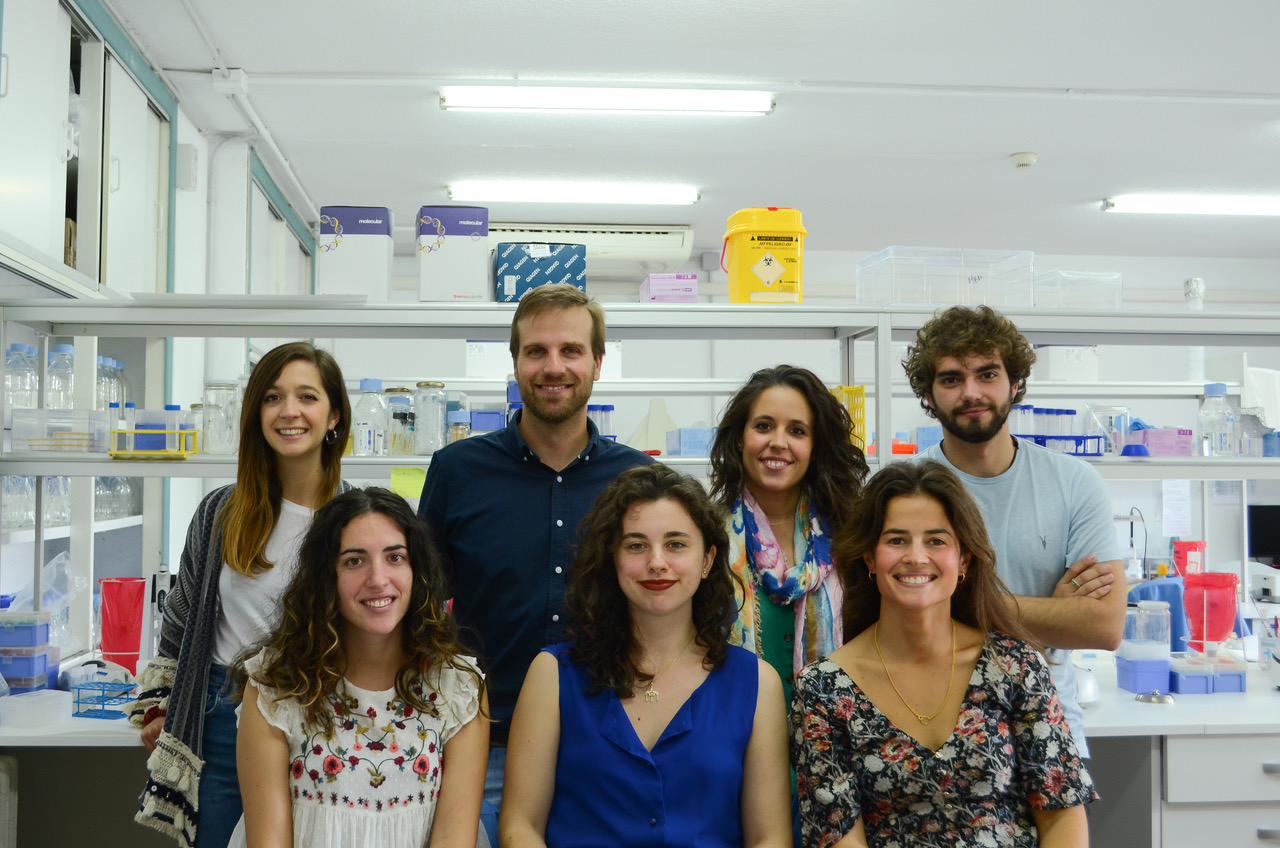
Group photo. From left to right: Paula Blanco, Ester Vergara, José Antonio Escudero (IP), Carlota Pintado, Lucía García Pastor, Filipa Trigo da Roza and Alberto Hipólito.
The Molecular Bases of Adaptation (MBA) group is a recently created group at the UCM Faculty of Veterinary Medicine (www.ucm.es/mbalab). It currently consists of 7 members whose work focuses on the study of integrons, one of the most important genetic platforms in the world of antibiotic resistance. The importance of integrons lies in their high prevalence in Gram negatives, in the adaptive power they confer on their host and in the subtle synchronization with the needs of the bacteria that allows limiting their biological cost (Escudero et al., 2015).
Integrons are capable of capturing and incorporating new genes into the bacterial genome that are embedded in a mobilizable structure called cassette. The integration of these cassettes occurs through recombination between their site attC and the integration site attI in the integron (Mazel, 2006). These reactions are carried out by integrase which is encoded in the single gene of the integron platform. Cassette genes are generally promoterless and become functional by integrating into the site attI, since the integron has a dedicated promoter for its transcription: the Pc. The integrons can capture and accumulate a variable number of cassettes, and the level of expression of each one will depend on its distance from the PC. The cassette collection is stable under normal conditions due to the lack of expression of integrase. However, under stress conditions, integrase (whose transcription is controlled by the SOS response (Guerin et al., 2009)) is expressed and can produce, in addition to the integration of new cassettes if any, the excision and rearrangement of collection cassettes. This allows cassettes that are far away to be brought closer to the PC and thus increase their expression. This ability to acquire and accumulate new functions, added to the differential expression of the cassettes and the possibility of their rearrangement, make integrons low-cost bacterial adaptive memories.
Although the best-known integrons are the plasmid-borne antibiotic resistance-related integrons (so-called mobile integrons), these are not actually the native form of integron, but the result of stochastic mobilization of some integrons from chromosomes. of environmental bacteria. Indeed, we found integrons in the chromosomes of more than 10% of the bacteria in the databases, which shows that they are structures with a distant evolutionary origin (Cury et al., 2016; Rowe-Magnus et al., 2001) . These sedentary chromosomal integrons (ICS) generally contain cassettes of unknown function and generally unrelated to antibiotic resistance. It follows that some of these ICS have been mobilized by transposons to plasmids, and have reached bacteria of clinical interest, where the ability to capture resistance cassettes has been of great adaptive value to their hosts, giving rise to mobile integrons.
MBA members are interested in many different facets of integrons, from the adaptability they confer on bacteria to their evolutionary origin. On the one hand, we work on trying to obtain a clear and quantified overview of the adaptive value of resistance integrons for clinical bacteria. To do this, Alberto Hipólito measures these parameters of all the resistance genes described to date (more than 170!). On the other hand, Filipa Trigo da Roza is working on the development of a biotechnological tool that allows us to capture and identify the content of resistance cassettes in DNA samples from patients, animals or the environment. But there are very interesting things about integrons outside the field of resistance. Carlota Pintado studies the evolutionary origin of integron integrases, studying the role of the I2 domain of integrase. This domain is only found in integron integrases and allows sites to be recognized attC of the cassettes, but we do not know their role when integrases carry out ancestral-type reactions in which there is no attCs(Escudero et al., 2016). For her part, Paula Blanco studies the functions of chromosomal integron cassettes, which are assumed to have an important evolutionary value, but their function is completely unknown (Escudero and Mazel, 2017); and Lucía García-Pastor works on elucidating how the cassettes are generated again, a fundamental phenomenon of integron functioning for which there is no clear model, but which may have a direct connection with the evolutionary origin of integrons (Escudero et al., 2015). And so that we do not lack for anything, Ester Vergara, our laboratory technician, assists all of us.
The objective of MBA, in short, is to understand the adaptive value of integrons in hospitals and outside of them. For this, we have the financial support of the Talent Attraction Plan of the Community of Madrid; the Ministry of Science, Innovation and Universities through its R&D Excellence projects; and the European Research Council through a Starting Grant. We are very grateful to all of them.
Representative bibliography
Cury, J., Jove, T., Touchon, M., Neron, B., and Rocha, E.P. (2016). Identification and analysis of integrons and cassette arrays in bacterial genomes. Nucleic Acids Res 44, 4539-4550.
Escudero, J.A., Loot, C., Nivina, A., and Mazel, D. (2015). The Integron: Adaptation On Demand. Microbiol Spectr 3, MDNA3-0019-2014.
Escudero, J.A., Loot, C., Parissi, V., Nivina, A., Bouchier, C., and Mazel, D. (2016). Unmasking the ancestral activity of integron integrases reveals a smooth evolutionary transition during functional innovation. Nat Commun Ferrándiz MJ, Martín-Galiano AJ, Arnanz C, Camacho-Soguero I, Tirado-Vélez JM, de la Campa AG., 10937.
Escudero, J.A., and Mazel, D. (2017). Genomic Plasticity of Vibrio cholerae. Int Microbiol 20, 138-148.
Guerin, E., Cambray, G., Sanchez-Alberola, N., Campoy, S., Erill, I., Da Re, S., Gonzalez-Zorn, B., Barbe, J., Ploy, M.C., and Mazel, D. (2009). The SOS response controls integrate recombination. Science 324, 1034.
Mazel, D. (2006). Integrons: agents of bacterial evolution. Nat Rev Microbiol 4, 608-620.
Rowe-Magnus, D.A., Guerout, A.M., Ploncard, P., Dychinco, B., Davies, J., and Mazel, D. (2001). The evolutionary history of chromosomal super-integrons provides an ancestry for multiresistant integrons. Proc Natl Acad Sci U S A 98, 652-657.
